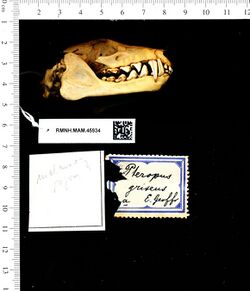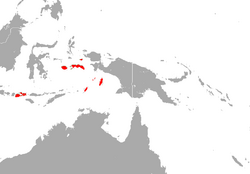Biology:Black-bearded flying fox
| Black-bearded flying fox | |
|---|---|

| |
| Scientific classification | |
| Domain: | Eukaryota |
| Kingdom: | Animalia |
| Phylum: | Chordata |
| Class: | Mammalia |
| Order: | Chiroptera |
| Family: | Pteropodidae |
| Genus: | Pteropus |
| Species: | P. melanopogon
|
| Binomial name | |
| Pteropus melanopogon Peters, 1867
| |

| |
| Black-bearded flying fox range (map also includes range of Aru Flying Fox and Kei Flying Fox) | |
| Synonyms | |
| |
The black-bearded flying fox (Pteropus melanopogon) is an endangered species of megabat in the genus Pteropus.[1] It is endemic to Indonesia, found on the islands of Ambon, Buru, Seram, Banda, and Yamdena.[2] Currently considered monotypic, it formerly included the Aru flying fox and Kei flying fox as subspecies.[2]
Taxonomy and etymology
It was described in 1867 by German naturalist Wilhelm Peters based on an individual in the collection of Hermann Schlegel.[3] Its species name comes from the Neo-Latin melanin, which is derived from Ancient Greek "mélas", meaning "black", and Ancient Greek pṓgōn, meaning "beard". As the genus Pteropus is speciose, it is divided into closely related species groups. The black-bearded flying fox is identifier of the melanopogon species group, which also includes the following species:[2]
- Aru flying fox (Pteropus aruensis)
- Kei flying fox (Pteropus keyensis)
Description
Adults weigh approximately 510–900 g (1.12–1.98 lb). It is one of the heavier species of its family, based on the few individuals that have been weighed.[4] The fur is dark red on its brow, face, between the eyes, and under the jaw. On its head, neck, shoulders, and ventral side, it is bright reddish brown. Individual hairs are bicolored, with the base of the hair pale and yellowish while the tip is darker. Its dorsal surface is dark brown, with bright yellow hairs sparsely throughout. The uropatagium is covered with long, dark brown fur.[5] Its forearm is approximately 175–193 mm (6.9–7.6 in) long.[6] Its ears are shorter than its muzzle. While in many species of bats the wings attach to the sides of the body, in this species, the wings attach closer to the spine. The legs and forearms lack fur.[7] The baculum is 9.45 mm (0.372 in) long.[8] It has a robust skull compared to other members of its genus.[4]
Biology
It has been observed feeding on the flowers of durian trees.[1] It is a colonial species, forming roosts of up to 200 individuals. Colonies are usually conspecific, although they have been observed roosting with the Moluccan flying fox, though not in the same tree.[4] It is a known host of at least one species of mite in the family Gastronyssidae, Opsonyssus asiaticus, which lives in its nasal cavities.[9]
Range and habitat
It is endemic to the Maluku Islands, which are a part of Indonesia. The only known remaining colony roosts in mangrove forests on Seram Island.[1] In the past, its range included Ambon Island, Buru, Banda Islands, and Yamdena,[2] though there are no recent observations on any of these islands.[1]
Conservation
In the 1800s, its population was abundant.[4] It is currently evaluated as endangered by the IUCN. At present, there is only one colony of this species remaining, and it consists of fewer than 200 individuals.[1] The species is not protected, and the habitat that supports the remaining colony is not protected either.[4] From 2016–2049, its population is expected to decline by 50%. Threats to this species include habitat destruction via deforestation and overhunting for bushmeat.[1] Because it is a highly-colonial species, it is a popular target for hunters, and its population is vulnerable to drastic decline.[4]
References
- ↑ 1.0 1.1 1.2 1.3 1.4 1.5 1.6 Tsang, S. (2016). "Pteropus melanopogon". IUCN Red List of Threatened Species 2016: e.T18739A22082983. doi:10.2305/IUCN.UK.2016-3.RLTS.T18739A22082983.en. https://www.iucnredlist.org/species/18739/22082983. Retrieved 16 November 2021.
- ↑ 2.0 2.1 2.2 2.3 Wilson, D.E.; Reeder, D.M., eds (2005). Mammal Species of the World: A Taxonomic and Geographic Reference (3rd ed.). Johns Hopkins University Press. ISBN 978-0-8018-8221-0. OCLC 62265494. http://www.departments.bucknell.edu/biology/resources/msw3/browse.asp?id=13800330.
- ↑ Peters, Wilhelm (1867). "über die Flederhunde, Pteropi, und insbesondere über die Arten der Gattung Pteropus s.s.". Monatsberichte der Königlich Preußischen Akademie der Wissenschaften zu Berlin 1867: 319–333. https://www.biodiversitylibrary.org/item/112419#page/328/mode/2up. Retrieved 28 August 2017.
- ↑ 4.0 4.1 4.2 4.3 4.4 4.5 Tsang, S.M.; Wiantoro, S.; Simmons, N.B. (2015). "New Records of Flying Foxes (Chiroptera: Pteropus sp.) from Seram, Indonesia, with Notes on Ecology and Conservation Status". American Museum Novitates (3842): 1–23. doi:10.1206/3842.1. http://digitallibrary.amnh.org/bitstream/handle/2246/6622/N3842.pdf?sequence=1.
- ↑ Dobson, G.E. (1877). "On a Collection of Chiroptera from Duke-of-York Island and the adjacent parts of New Ireland and New Britain". Proceedings of the Scientific Meetings of the Zoological Society of London (Longman, Green, Longmans, and Roberts): 115–116. https://archive.org/details/biostor-102829.
- ↑ Flannery, T. (1995). Mammals of the South-West Pacific & Moluccan Islands. Cornell University Press. pp. 245–303. ISBN 978-0801431500.
- ↑ Andersen, Knud (1912). Catalogue of the Chiroptera in the collection of the British Museum. 1 (2nd ed.). London: British Museum (Natural History). Department of Zoology . [Mammals].. pp. 44–47. doi:10.5962/bhl.title.8322. https://www.biodiversitylibrary.org/item/34531#page/788/mode/2up. Retrieved October 26, 2017.
- ↑ Hosken, D.; Jones, K.; Chipperfield, K.; Dixson, A. (2002). "Is the bat os penis sexually selected?". Behavioral Ecology and Sociobiology 51 (3): 302–307. doi:10.1007/s00265-001-0437-z.
- ↑ Fain, A.; Lukoschus, F. S. (1979). "Parasites of Western Australia. 5. Nasal mites from bats (Acari: Gastronyssidae and Ereynetidae)". Records of the Western Australian Museum 7 (1): 57–60. http://museum.wa.gov.au/sites/default/files/PARASITES%20OF%20WESTERN%20AUSTRALIA%20V%20NASAL%20MITES%20FROM%20BATS%20(ACARI%20GASTRONYSSIDAE%20AND%20EREYNETIDAE)%20(1).pdf.
Wikidata ☰ Q1947353 entry
 |


